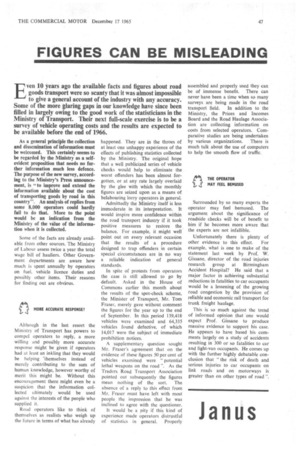FIGURES CAN BE MISLEADING
Page 49

If you've noticed an error in this article please click here to report it so we can fix it.
Even 10 years ago the available facts and figures about road goods transport were so scanty that it was almost impossible to give a general account of the industry with any accuracy. Some of the more glaring gaps in our knowledge have since been filled in largely owing to the good work of the statisticians in the Ministry of Transport. Their next full-scale exercise is to be a survey of vehicle operating costs and the results are expected to be available before the end of 1966.
As a general principle the collection and dissemination of information must be welcomed. This certainly seems to be regarded by the Ministry as a selfevident proposition that needs no further information much less defence. The purpose of the new survey, according to the Ministry's Press announcement, is "to improve and extend the information available about the cost of transporting goods by road in this country". An analysis of replies from some 8,000 operators could hardly fail to do that. More to the point would be an indication from the Ministry of the value of the information when it is collected.
Some of the facts are already available from other sources. The Ministry of Labour assess twice a year the total wage bill of hauliers. Other Government departments are aware how much is spent annually by operators on fuel, vehicle licence duties and possibly other items. Their reasons for finding out are obvious.
Although in the last resort the Ministry of Transport has powers to compel operators to reply, a more willing and possibly more accurate response might be given if operators had at least an inkling that they would be helping 'themselves instead of merely contributing to the sum of human knowledge, however worthy of merit this might be. Without this encouragement there might even be a suspicion that the information collected ultimately would be used against the interests of the people who supplied it.
Road operators like to think of themselves as realists who weigh up the future in terms of what has already happened. They are in the throes of at least one unhappy experience of the effects of publishing statistics collected by the Ministry. The original hope that a well publicized series of vehicle checks would help to eliminate the worst offenders has been almost forgotten, or at any rate largely overlaid by the glee with which the monthly figures are seized upon as a means of belabouring lorry operators in general.
Admittedly the Ministry itself is less immoderate in its interpretation. It would inspire more confidence within the road transport industry if it took positive measures to restore the• balance. For example, it might well point out on every relevant occasion that the results of a procedure designed to trap offenders in certain special circumstances are in no way a reliable indication of general standards.
In spite of protests from operators the case is still allowed to go by default. Asked in the House of Commons earlier this month about the results of the spot-check scheme, the Minister of Transport, Mr. Tom Fraser, merely gave without comment the figures for the year up to the end of September. In this period 139,418 vehicles were examined and 64,335 vehicles found defective, of which 14,017 were the subject of immediate prohibition notices.
A supplementary question sought Mr. Fraser's agreement that on the evidence of these figures 50 per cent of vehicles examined were "potential lethal weapons on the road ". As the Traders Road Transport Association pointed out subsequently the figures mean nothing of the sort. The absence of a reply to this effect from Mr. Fraser must have left with most
people the impression that he was inclined to agree with the questioner_
it would be a pity if this kind of experience made operators distrustful of statistics in general_ Properly assembled and properly used they can be of immense benefit. There can never have been a time when so many surveys are being made in the road transport field. In addition to the Ministry, the Prices and Incomes Board and the Road Haulage Association are collecting information on costs from selected operators. Cornparative studies are being undertaken by various organizations. There is much talk about the use of computers to help the smooth flow of traffic.
Surrounded by so many experts the operator may feel bemused. The argument about the significance of roadside checks will be of benefit to him if he becomes more aware that the experts are not infallible.
Unfortunately there is plenty of other evidence to this effect. For example, what is one to make of the statement last week by Prof. W. Gissane, director of the road injuries research group at Birmingham Accident Hospital? He said that a major factor in achieving substantial reductions in fatalities to car occupants would be a lessening of the growing road congestion by the provision of reliable and economic rail transport for trunk freight haulage.
This is so much against the trend of informed opinion that one would expect Prof. Gissane to produce massive evidence to support his case. He appears to have based his comments largely on a study of accidents resulting in 300 or so fatalities to car and light-van occupants. He comes up with the further highly debatable conclusion that "the risk of death and serious injuries to car occupants on link roads and on motorways is greater than on other types of road ".












































































































